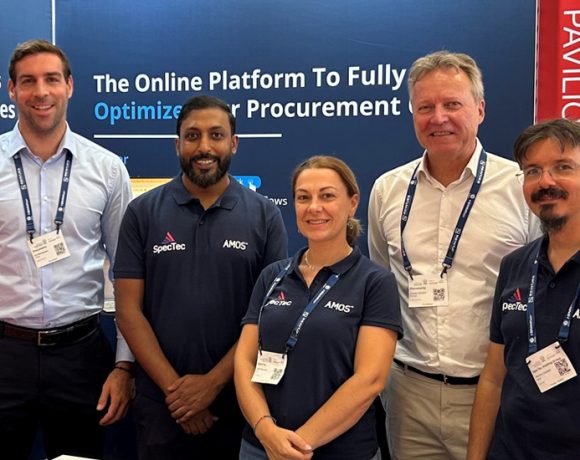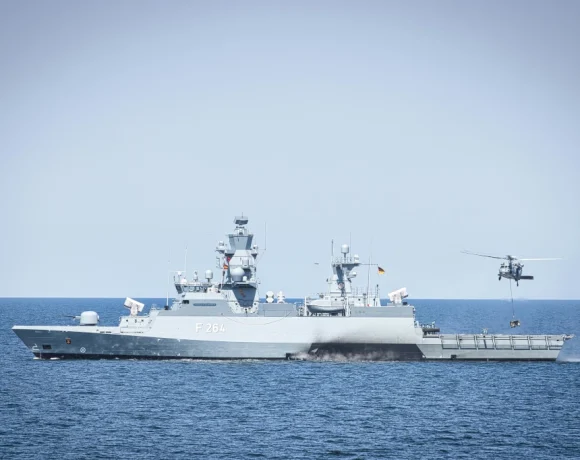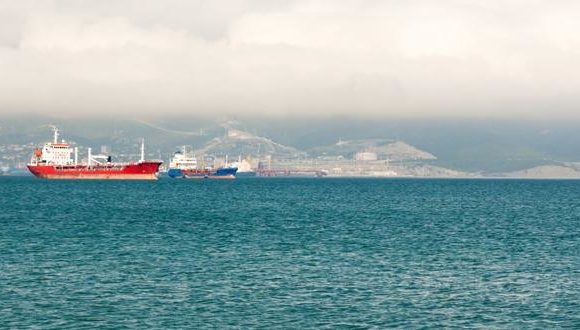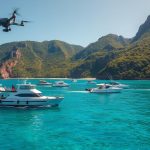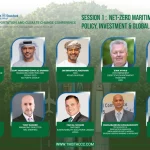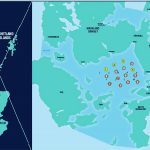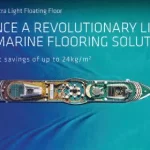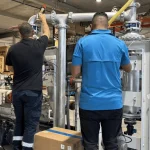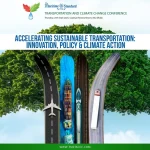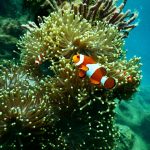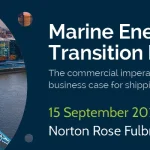Marine Ecology News Digest June 2025

Over 73% of our planet’s oceanic systems saw temperature changes in the first quarter of 2025. This is the biggest data collection effort in maritime history.
New monitoring technologies give us deep insights into underwater worlds. These tools help scientists track changes with great accuracy. This knowledge is vital for more than just research.
In Britain, industry and conservation groups get real-time oceanic data. This technology change helps us understand marine life better. It makes tracking species migrations more precise than ever.
Global partnerships help us understand complex underwater worlds. Teams share research findings quickly across the world. This teamwork boosts both sea trade and environmental protection.
June 2025 marks a big leap in marine ecology research. We look at new findings that change how we see ocean health and ecosystems.
Breakthrough Coral Reef Restoration Projects Transform UK Coastal Waters
Breakthrough coral restoration projects have changed how we fix marine ecosystems in British waters. These projects mix advanced scientific techniques with community help to get great results. The National Oceanography Centre in Southampton has made coral grow 50% faster than before. They do this by giving coral the right nutrients and light.
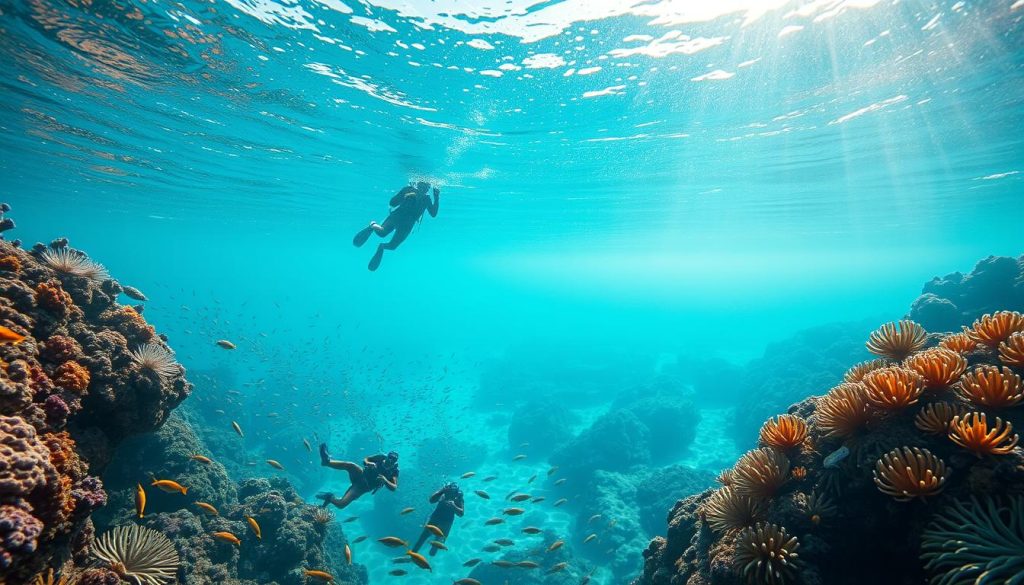
New ways are changing coral reef ecology in many UK areas. Scientists have made 3D-printed reef structures. These structures have different coral species and help them grow well.
Revolutionary Coral Transplantation Techniques in Cornwall
Cornwall’s coast is testing new coral transplant methods. Marine biologists use advanced aquaculture systems to help coral grow faster. They control the environment to speed up coral development.
These methods include:
- Optimised nutrient delivery systems for enhanced growth
- Precision lighting technology mimicking natural conditions
- Heat-resistant coral strain development
- 3D-printed reef modules supporting diverse species
Community-Led Restoration Initiatives Across Devon
Devon communities are leading marine conservation efforts. They have citizen science programmes. Local volunteers and researchers work together to create coral nurseries.
These efforts have seen 85% survival rates for coral fragments. The community also gets training and education on marine conservation.
Scientific Partnerships with Marine Conservation Organisations
Academic institutions and marine conservation groups are working together. This partnership helps share knowledge and resources. It makes restoration efforts more effective.
This teamwork has led to over 15,000 lab-grown coral fragments being planted. It shows the strength of working together for marine conservation.
Endangered Marine Species Recovery Programmes Show Remarkable Progress
Efforts to save endangered marine species have led to big wins in marine habitats. These programs show how focused actions can bring back threatened species and keep the ecosystem in balance. Scientists have seen real changes in many species in UK waters.
Atlantic Salmon Population Surge in Scottish Rivers
Scottish rivers are seeing a big comeback of Atlantic salmon thanks to new ways to fix habitats. Fish ladders help salmon swim up rivers to spawn again. New tech tracks how they move, helping to make conservation plans better.
Projects to fix rivers have removed old barriers for salmon. This helps their numbers grow and keeps their important breeding spots safe from people.
Grey Seal Conservation Success Stories
Grey seals are doing well in British coastal ecosystems thanks to strong protection. Safe places for them to have pups mean less disturbance. Surveys show their numbers are going up, with some groups growing by over 20% in a few years.
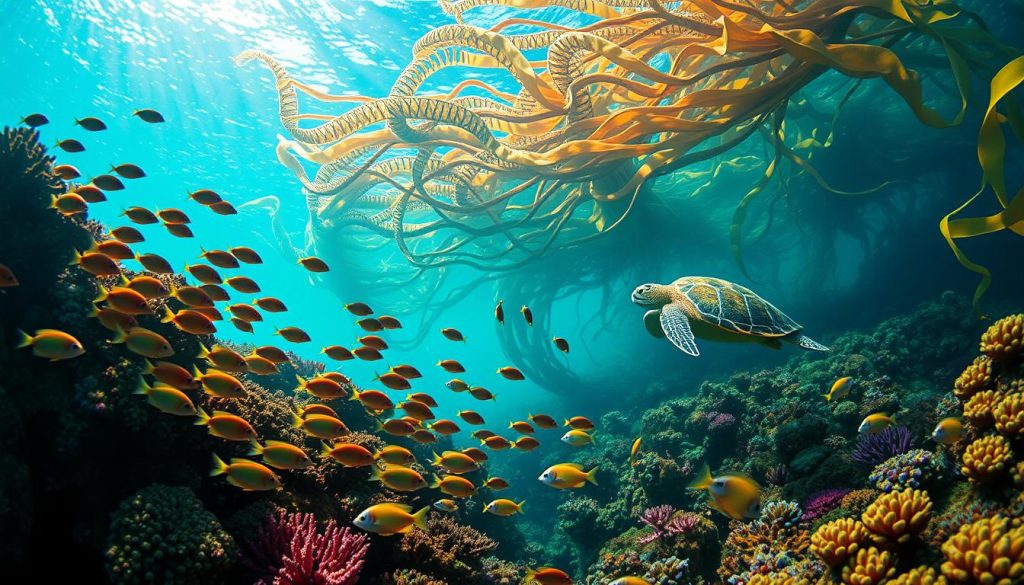
Working together, locals help protect marine habitats. This teamwork makes a big difference in keeping these areas safe.
Basking Shark Monitoring Reveals Population Growth
Basking sharks in the Celtic Sea are doing better, with 127 found, a 15% increase from last year. New tracking tech shows where they go, helping plan how to protect them.
More protection in their food spots means fewer sharks get caught. Volunteers help by reporting shark sightings, adding to the research in coastal ecosystems.
Sustainable Fisheries Management Policies Reshape UK Waters
UK waters are changing thanks to new sustainable fisheries policies. The country is moving to Ecosystem-Based Fisheries Management. This means looking at the whole ecosystem, not just one species.
This new approach uses real-time data on fish, habitats, and the environment. After Brexit, fishing policies are based on science, not just politics.
New Quotas for Commercial Fishing Operations
Commercial fishing quotas now aim to protect the environment and support the economy. The North Sea has more herring to catch, thanks to better population checks.
Cod, though, needs more protection to stop its numbers from falling. These new rules use advanced models to keep the sea healthy.
Fishing crews get updates on their quotas online. This helps avoid overfishing and keeps fishing sustainable.
Innovative Fishing Gear Reduces Bycatch Significantly
Smart nets with sensors have cut unwanted catches by a lot. They can tell if a fish is the right one to catch and release it safely.
These nets have cut bycatch by 67% in some fleets. Artificial intelligence helps fishermen adjust their catch on the spot.
Acoustic devices are also helping. They use sound to keep marine mammals safe, reducing bycatch by up to 85%.
Collaboration Between Fishermen and Marine Biologists
Fishermen and scientists are working together like never before. They’re using old fishing knowledge and new science to protect the sea.
They share data on fish and the sea. Fishermen’s insights help scientists understand the ocean better.
Together, they’re testing new fishing methods. This shows how science and fishing skills can protect the sea and help local communities.
Marine Pollution Reduction Initiatives Gain Momentum Nationwide
Revolutionary marine pollution reduction strategies are changing UK coastal management. They use waste elimination programmes and advanced industrial monitoring. These efforts are a big step towards protecting British waters.
Community-led initiatives and cutting-edge technology are solving pollution problems. Local groups and environmental organisations are working together. They set up waste management systems to stop pollution from harming marine life.
Plastic Waste Elimination Programmes in Coastal Towns
Coastal towns in Britain are tackling plastic waste with new programmes. They use circular economy principles and innovative recycling. The goal is to find plastic-free alternatives for local businesses and tourism.
Beach cleanups led by communities are making a big difference. They have removed over 12 tonnes of debris from 78 beaches. This shows how effective these efforts can be.
Waste processing technologies and education programmes are working together. They create systems that stop plastic pollution and encourage lasting changes in behaviour.
Industrial Discharge Monitoring Systems Upgraded
Industrial facilities have upgraded their discharge monitoring systems. They now have real-time chemical analysis and automated alerts. These oceanography-based technologies help respond quickly to pollution threats.
Advanced sensors monitor water quality all the time. They give industries accurate data on their compliance. This helps industries take proactive steps to protect the environment.
Microplastic Research Reveals Concerning Trends
Research by the University of Liverpool has found high levels of microplastics in British waters. The Irish Sea has an average of 5.7 microplastic particles per cubic metre. Levels are higher near cities.
Textile and packaging waste are the main causes of microplastic pollution. This research shows we need to act fast. We need source reduction strategies and better waste management.
Citizen science projects help monitor pollution and engage communities. This approach combines scientific research with practical actions. It creates lasting solutions for marine conservation.
Marine Ecology Research Breakthroughs Unveil Ocean Mysteries
British scientists are making huge strides in understanding the ocean. Their marine ecology research is changing how we see underwater worlds. New methods let them explore places that were once off-limits.
Deep-Sea Ecosystem Discoveries Off Scottish Coast
Teams have found 17 new species in the Atlantic’s deepest parts. These include creatures that light up the dark with special powers. They’ve also found fish that can handle the pressure without any special features.
These discoveries show how diverse life can be in the deep sea. Each species has its own way of surviving in the harsh conditions. They live in total darkness and extreme pressure.
Climate Change Impact Studies on Marine Biodiversity
Scientists are tracking how species move as the environment changes. They use advanced maths to forecast what will happen next. This helps them spot which species need help the most.
By studying how life adapts to climate change, they gain valuable insights. They watch how populations change with temperature shifts. This knowledge is key to saving endangered marine life.
Technological Advances in Underwater Research Methods
Plymouth Marine Laboratory uses top-notch underwater robots for deep dives. These robots can handle the pressure and collect detailed samples. Autonomous underwater vehicles also have cameras and send data back in real-time.
The University of Southampton found life forms that can survive in scorching hot conditions. These breakthroughs allow scientists to study the ocean without harming it. They help the sea industry by improving how they check the environment.
Coastal Ecosystem Restoration Projects Deliver Environmental Benefits
Coastal restoration projects show how nature can help our planet. They make marine habitats stronger and help us adapt to climate change. These efforts along UK shores have been very successful in fixing damaged areas.
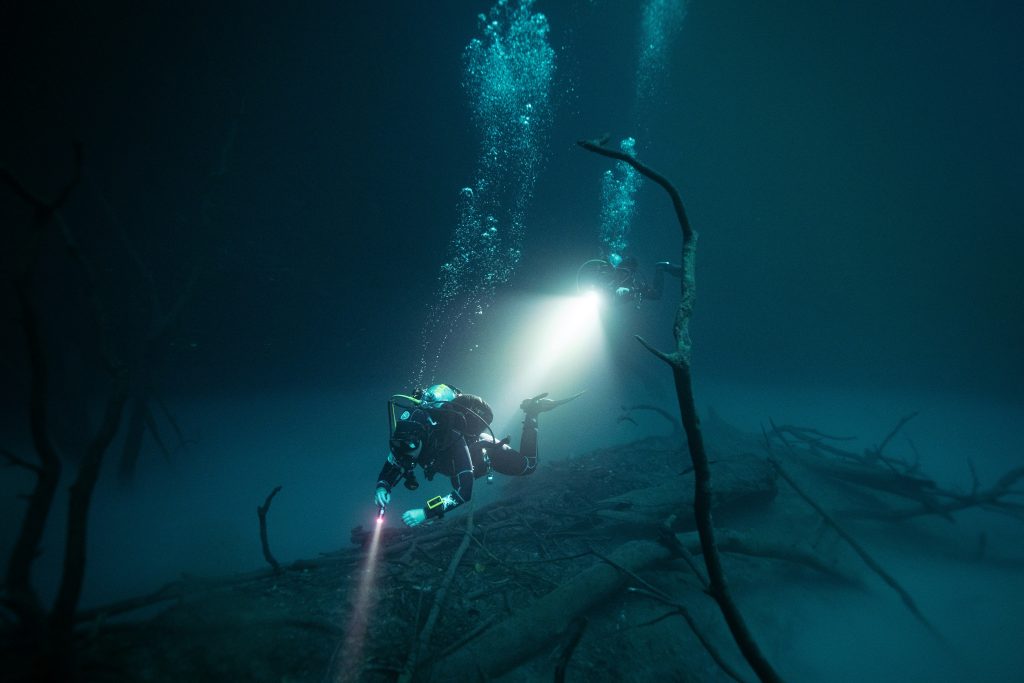
There’s a big team effort between groups like the RSPB, local people, and scientists. This teamwork makes sure these projects last and do good for the environment.
Saltmarsh Rehabilitation Along East Anglian Coast
East Anglia’s coastal ecosystems have seen big improvements thanks to saltmarsh restoration. Over 150 hectares have been fixed up. New plants and special ways of managing sand have helped.
Experts use special models to make sure the saltmarshes grow right. These restored areas help fight climate change and protect nearby towns from floods.
Seagrass Meadow Recovery in Welsh Waters
Welsh waters have seen a big win with seagrass restoration. Over 20 hectares have been replanted with local plants. These underwater marine habitats are great at pulling CO2 out of the air, even more than trees.
Seagrass meadows are also key for young fish and shellfish. They help these creatures grow strong. This makes the meadows a safe place for many species.
Dune System Stabilisation Programmes
New methods use plants and careful planning to fix dunes. Plants that hold sand in place and paths that don’t harm the area help. This way, people can enjoy the coast while it’s being protected.
Volunteers play a big role in keeping the coastal ecosystems in good shape. Their work helps the habitats grow and stay safe for the future.
Marine Protected Areas Expansion Enhances Conservation Efforts
The UK is making big steps in marine conservation by growing Marine Protected Areas. This move is key to protecting marine life and supporting the sea’s health. It also helps the maritime industry grow in a sustainable way.
This effort is a big step towards protecting 30% of national waters by 2030. It creates a network of protected areas. This network helps species move and mix, keeping ecosystems healthy.
New Designated Marine Conservation Zones
New zones are chosen based on science. They pick areas that are rich in life, connected, and at risk from humans.
Scientists, fishermen, and conservation groups work together to decide on these zones. This way, we protect the sea while also supporting those who use it.
Highly Protected Marine Areas get the strongest protection. They stop activities that harm the sea. This lets the sea heal and helps scientists learn more.
Enhanced Protection for Critical Breeding Grounds
There are rules to keep breeding areas safe for seabirds and marine mammals. This lets them have a good chance of raising their young.
Systems watch how well they breed and grow. This helps us make the protection better over time.
Studies help us know how to protect vulnerable species during important times in their lives.
Stakeholder Engagement in Protected Area Management
Fishing communities, tourism, and conservation groups help make decisions. This way, everyone works together to protect the sea.
The Channel Islands show how working together can make a difference. They’ve added 150 square kilometres to protect the sea and support fishing.
Regular meetings keep everyone talking. This helps solve problems and keeps the focus on protecting the sea for the long term.
Oceanographic Studies Reveal Climate Change Impacts on Marine Habitats
Recent studies in UK waters show how climate change is affecting marine habitats. These studies give critical insights for maritime industry adaptation and conservation planning. They use advanced monitoring systems to track rapid environmental changes.
The data reveals alarming trends in British waters. Sea temperatures have risen by 0.5°C in the last decade. Some areas are warming at nearly double the global rate.
Temperature Rise Effects on Marine Food Chains
Rising sea temperatures are causing cascading ecological impacts in UK waters. The North Sea and English Channel are experiencing severe thermal stress. This stress is disrupting traditional predator-prey relationships.
Plankton communities are changing dramatically. These tiny organisms are key to marine food webs. Commercial fish are moving north to find cooler waters.
Maritime industries must adapt to these changes. Fisheries need new management strategies. Coastal communities must update their infrastructure.
Ocean Acidification Monitoring Results
Monitoring shows accelerating pH reductions in UK waters. Automated buoys with precision sensors provide real-time data. This helps researchers track seasonal changes.
Calcifying organisms are facing growing threats from acidification. Shellfish, corals, and plankton are struggling to survive. These changes harm coastal ecosystems and commercial shellfish operations.
Sea Level Rise Implications for Coastal Ecosystems
Sea level rise poses complex challenges beyond flooding. Saltwater intrusion harms freshwater habitats. Coastal ecosystems must move inland or risk extinction.
Advanced hydrodynamic modelling predicts habitat changes. This research guides coastal management decisions. Maritime spatial planning now includes these projections for sustainable development.
Marine Environmental Impact Assessments Drive Policy Changes
Strategic environmental assessments are leading to big changes in the UK’s marine industries. These detailed checks set new standards for sustainable development and protecting the environment in British waters. The maritime sector uses advanced impact modelling to grow economically while keeping the environment safe.
Modern assessment methods use the latest monitoring tech and real-time data. This helps policymakers make better decisions about marine environmental impact. It also supports the growth of the industry. Sustainable fisheries management gets a big boost from these improved evaluations.
Offshore Wind Farm Environmental Considerations
Offshore wind farms face strict environmental checks. Sophisticated ecosystem impact modelling looks at risks to seabirds and marine mammals during setup. Real-time wildlife tracking is used throughout the project’s life.
These checks use top-notch acoustic monitoring and satellite tracking. This approach reduces harm to the marine environment while increasing renewable energy.
Shipping Industry Sustainability Measures
New rules are in place for maritime transport in UK waters. These rules demand cleaner fuels, energy-saving tech, and better routes. Advanced vessel monitoring systems track compliance and environmental performance in real-time.
These steps tackle ballast water, air emissions, and underwater noise. The shipping industry follows sustainable fishing by reducing environmental harm and improving efficiency.
Coastal Development Regulations Strengthened
Integrated assessments now look at total environmental impacts and climate resilience. New rules require developers to show net environmental gain through habitat projects. These must outweigh project impacts to get approval.
The maritime industry uses climate data and predictive modelling for planning. This approach helps adapt proactively while following rules across different sectors.
Conclusion
In June 2025, we saw big steps forward in marine ecology and conservation in UK waters. Research groups, government bodies, and sea industries found new ways to protect the environment while supporting the economy.
Projects in Cornwall and Devon to restore coral reefs show how important community involvement is. The comeback of endangered species like Atlantic salmon and grey seals shows that focused efforts can make a difference. This success comes from working together between scientists and local people.
Efforts to manage fisheries and cut pollution are setting new standards for taking care of the ocean. More Marine Protected Areas are being created, giving vital habitats while also supporting safe sea travel. New technologies like artificial intelligence and advanced monitoring systems are changing how we protect marine life.
Despite the challenges posed by climate change, there’s hope for the health of our oceans. The use of advanced technology and real-world experience is leading to better ways to manage our oceans.
Maritime experts can use these findings to plan better for the future. As we move towards our 2030 goals, it’s clear that combining science, technology, and community involvement is key. This balanced approach is the most effective way to protect our oceans as they change.

